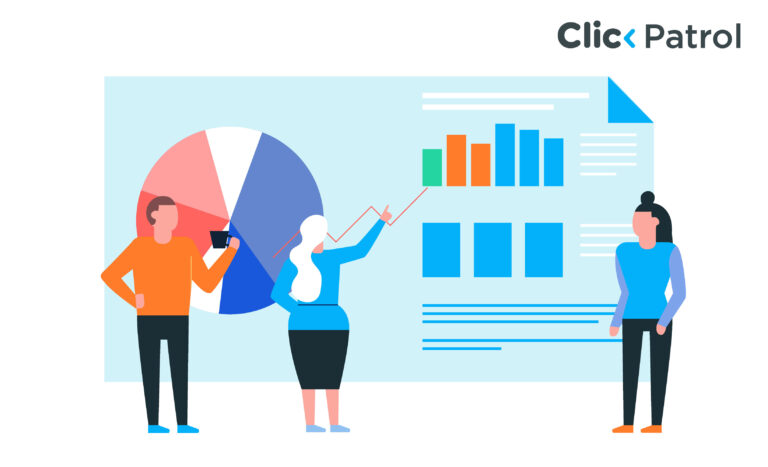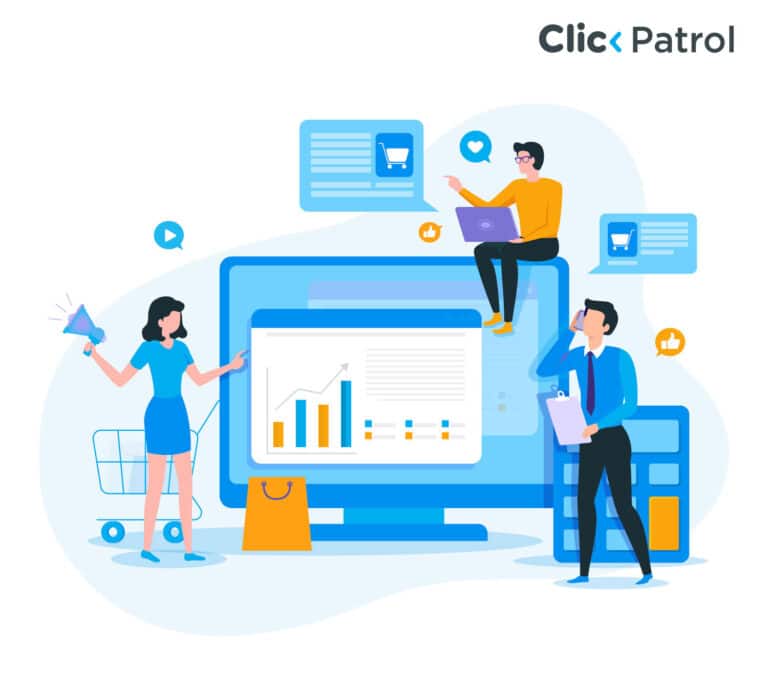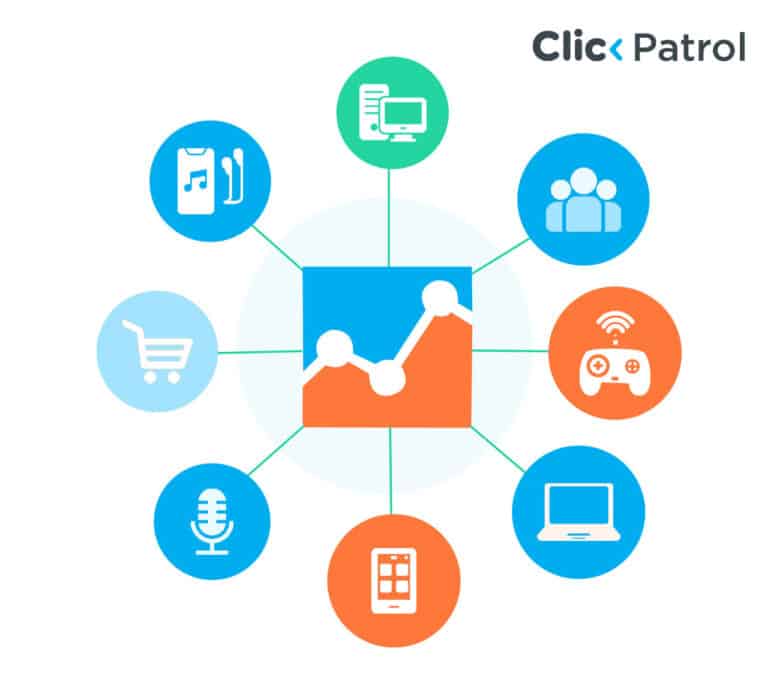
What Is The Relationship Between Invalid Clicks And Remarketing?
Abisola Tanzako | Apr 08, 2024

Table of Contents
- What is Remarketing?
- How does Remarketing work?
- Relationship between invalid clicks and remarketing
- How to mitigate the impact of invalid clicks
- Why you should still use remarketing
- 1. Facilitates brand recall
- 2. It is cost-effective
- 3. Increased return on investment (ROI)
- 4. Increases ad relevance
- 5. Particular targeting choices
- Tools used for Remarketing
- Remarketing via Google Ads
- Remarketing via Google Analytics
- Remarketing via Facebook Pixel
- Remarketing via Emails
- Conclusion
Is there a relationship between invalid clicks and remarketing?
Digital advertising is growing faster and faster every day, and every click has the potential to become a customer. On the other hand, the threat of Invalid clicks looms stronger and stronger.
Invalid clicks are fraudulent activities that involve clicking on internet ads illegitimately. They can have severe repercussions for marketers, particularly when combined with remarketing, one of the most effective strategies for advertisers. This article will explore the correlation between Invalid clicks and remarketing and its significant influence on digital advertising strategies.
What are invalid clicks?
Invalid clicks are deliberate clicks on online ads by individuals or computer programs to defraud advertisers or harm their advertising operations. They can squander money and are unfair. Platforms such as Google employ witty ways to prevent Invalid clicks and keep every ad as honest as possible.
Invalid clicks affect about 20% of paid internet links, such as display ads or search results. Thus, how are your advertising campaigns safeguarded from fraudulent practices by major advertising organizations like Google? Google uses manual filters, advanced algorithms, and other techniques to stop Invalid clicks, protect advertisers and maintain a fair and reliable advertising environment.
What is Remarketing?
Remarketing is sometimes referred to as retargeting. Ads Remarketing is a digital advertising strategy that enables websites to display tailored advertisements to individuals who have previously engaged with their platform. When users read news websites, view YouTube videos, or surf the internet, these advertisements will show up. The intention is to stay on their minds about your brand and entice them to visit your website again for more interaction.
Remarketing/retargeting can significantly improve your conversion rates and return on investment (ROI). Targeting people who have already visited your website increases the likelihood that they will make a purchase or take other beneficial actions on it because they are already familiar with your brand.
How does Remarketing work?
Remarketing operates by installing cookies that satisfy your specified criteria (s) on website users’ devices. You’ve added their cookie ID to your list of retargeting audiences. Once cookies are installed on their page, you can monitor visitors’ actions and navigation on your website. This enables you to assess users’ interests by understanding how long they spend on particular pages.
Knowing what your user is interested in allows you to target him with ads related to that interest and provide extra incentives to encourage a purchase. You can also remarket to your current customers, remind them of impending specials and discounts, and even offer them a special deal just for members. This way, you’ll segment your existing client database based on your campaign’s goal. Several tools and services, such as Facebook Ads, Google Ads, Facebook Pixel, MailChimp, and more, can be used for remarketing. or instance;
Say you are in charge of an online clothes store, and your best-selling items are your “wide-legged pants”. With remarketing, you can now create an audience for “Wide-Legged pants” based on users’ actions on this product page.
These visitors will be able to see highly targeted display adverts that promote your wide-legged pants. Since you already know what interests them, you use a special deal to lure them to purchase, such as free delivery, a 10% discount, or buy one get one free.
Relationship between invalid clicks and remarketing
In digital marketing, remarketing has presented itself as a powerful strategy to re-engage potential customers who have previously interacted with your website. However, amidst the success stories and promising results of remarketing campaigns, there lurks a significant threat that can sabotage its effectiveness and drain resources, some of which include:
1. Budget drainage:
One of the most immediate impacts of invalid clicks is the waste of ad budget. Remarketing campaigns target users who have already shown interest in the brand, so each click should be valuable for potential conversion. However, when a significant portion of clicks are invalid, the budget allocated for remarketing is squandered, leading to a decrease in ROI.
2. ROI reduction:
Invalid clicks directly decrease remarketing efforts’ return on investment (ROI). Since these clicks do not result in genuine user engagement or conversions, the resources spent on reaching these users do not yield the desired outcomes. This can be particularly frustrating for marketers who rely on remarketing to drive conversions and maximize ROI.
3. Data distortion:
Another critical impact of invalid clicks is the distortion of campaign performance data and analytics. Recording many invalid clicks distorts important metrics like click-through rate (CTR), conversion rate, and cost per acquisition (CPA). This distorted data makes it challenging for marketers to accurately assess the effectiveness of their remarketing strategies and make informed optimization decisions.
4. Ad performance decline:
Invalid clicks can also impact the overall efficacy of remarketing campaigns. When a significant portion of clicks are from something other than genuine users, it leads to lower engagement rates, reduced ad visibility, and, ultimately, lower chances of conversions. This doesn’t impact the current campaign and eventually tarnishes the brand’s reputation and trust among potential customers.
How to mitigate the impact of invalid clicks
Here is how you can reduce the impact of invalid clicks:
1. Click Fraud Detection Software: Leveraging click fraud detection tools such as ClickPatrol can help identify and filter out invalid clicks in real-time, minimizing their impact on remarketing campaigns.
2. Audience Segmentation: Refining audience segmentation based on user behaviour and engagement levels can help more effectively target high-value users and reduce exposure to invalid clicks.
3. Constant Monitoring: Regularly monitoring campaign performance metrics and click activity allows marketers to detect anomalies and take proactive measures to address invalid click issues promptly.
4. Ad Quality Optimization: Focusing on ad quality, relevance, and value proposition can attract genuine user engagement and reduce the likelihood of attracting invalid clicks.
5. Continuous Optimization: Continuously optimizing remarketing campaigns based on data-driven insights and performance analysis helps mitigate the impact of invalid clicks over time, improving overall ROI and campaign effectiveness.
The impact of invalid clicks on remarketing campaigns must be considered. Marketers must be vigilant, leverage technological solutions, and adopt best practices to minimize the adverse effects of invalid clicks and ensure the success of their remarketing strategies in driving conversions and maximizing ROI.
Why you should still use remarketing
Irrespective of the looming threat of invalid clicks, remarketing is a strategy advertisers should explore. Some of the benefits of remarketing include:
1. Facilitates brand recall
For a variety of reasons, customers visit your website but do not take any action (buy a good or service). Maybe they were looking at your options casually, forgot your website, found a better deal, or just wanted to take their time choosing. For any reason, you need to ensure that your clients remember you and your ultimate objective should always be to promote a call to action (CTA).
You can utilize remarketing to remind people of their past interests by using these customized ads, particularly if they’re searching for related products. This contributes to improved brand recall. Therefore, even if they decide not to buy it right away, they will remember your brand when they choose to buy it or something similar in the future.
2. It is cost-effective
It is no news that digital marketing is a very efficient and reasonably priced form of advertising with excellent results overall. Likewise, this applies to remarketing. Remarketing efforts don’t come with a hefty price tag, especially considering the outcomes that have been recorded. CMO states that retargeted advertising is preferred by 25% of viewers, and retargeted website visitors have a 43% higher conversion rate.
3. Increased return on investment (ROI)
Retargeting clients who have already visited your website and shown interest in your business will likely result in increased ROI because they have a greater intent than attempting to engage a larger audience that may or may not be interested. As a result, you will invest in clients who will become returning customers, helping you recover your costs and increase your earnings.
4. Increases ad relevance
Remarketing is a marketing technique for displaying advertisements based on past behaviour. It is so effective that, according to MotoCMS, it may improve online sales by over 20% and minimize cart abandonment by 6.5%. Customers are more inclined to take action if they are shown advertisements that align with their interests.
5. Particular targeting choices
Remarketing advertisements have several benefits, including their ability to target consumers based on various attributes specifically. Google says you can make multiple remarketing lists. For example, some people added items to a cart but never checked out.
Tools used for Remarketing
Now that you understand why remarketing is important let’s look at the top tools you can use for your remarketing
Remarketing via Google Ads
Google AdWords is a well-liked tool for many different digital marketing tactics and is quite beneficial for companies. Google Ads provides various types of remarketing from start to finish to particularly suit your remarketing strategy. We recommend you study Google Ads extensively.
Remarketing via Google Analytics
Google Analytics is best used as an analytical tool but can also be used for remarketing. To merge the data and carry out remarketing, you just have to connect your Google Ads and Google Analytics accounts. This may be very complex, requiring a thorough knowledge of both tools. Working with them becomes far more straightforward if you understand how they operate.
Remarketing via Facebook Pixel
It repeatedly targets individuals on Instagram and Facebook. Facebook Pixel code is used for remarketing.
A Facebook pixel is essentially a snippet of code that can be incorporated into your website to monitor conversions, create audiences, and gain valuable insights into user behaviour. You can track your visitors till they return to your website.
The pixel records various user behaviours on your website, such as making purchases or adding items to their wishlists. On Facebook, these behaviours are called “events.” With pixel code, a Facebook ad provides many features when paired.
Remarketing via Emails
You can remarket to users via email after evaluating their behaviour on your websites. You can launch three email remarketing campaigns, targeting three audiences based on the target group’s behaviour. However, this type of retargeting is only possible if you own the email addresses of every visitor to your website, making having a lead-generation strategy crucial. MailChimp is a well-liked email marketing platform.
Conclusion
Invalid clicks and remarketing are two aspects of digital marketing that interact complexly. If conscious actions are not taken to lessen their effects, invalid clicks threaten remarketing strategies’ efficiency, effectiveness, and financial sustainability. Advertisers must utilize sophisticated analytics, reliable ad platforms, and third-party detection solutions to effectively manage Invalid Clicks’ difficulties. However, if advertisers can effectively deal with invalid clicks, remarketing will significantly affect their ad performance in the long run.
FAQs
How do I enable remarketing on Google Ads?
It is easy to enable remarketing on Google Ads. Here is how to go about it:
1. Visit https://ads.google.com to sign in.
- Click on “Tools”.
- Select “Audience Manager”.
- Click “Audience Sources”.
- Click “Details” in the Google Ads tag card. Click “Set up tag” if you still need to set up the remarketing tag.
- Open the “Google Ads tag” section.
- Scroll down and select “Use Tag Manager”.
- Copy your “Conversion ID”.
2. Create a Google Ads Remarketing Tag.
- Go to “Tag Manager”
- Select” New Tag”> “Tag Configuration”> “Google Ads Remarketing”.
- Fill in the Google Ads Conversion ID.
- Click on “Triggering” and choose when the tag should fire.
- Click “Save”.
- Enable a conversion linker.
- Preview and publish.

